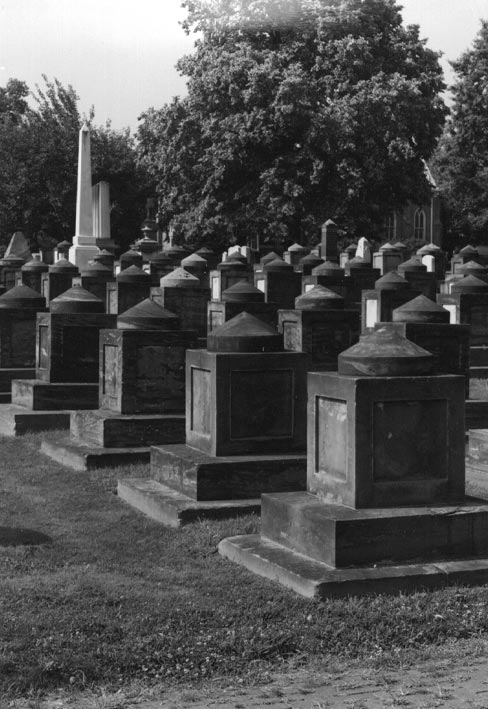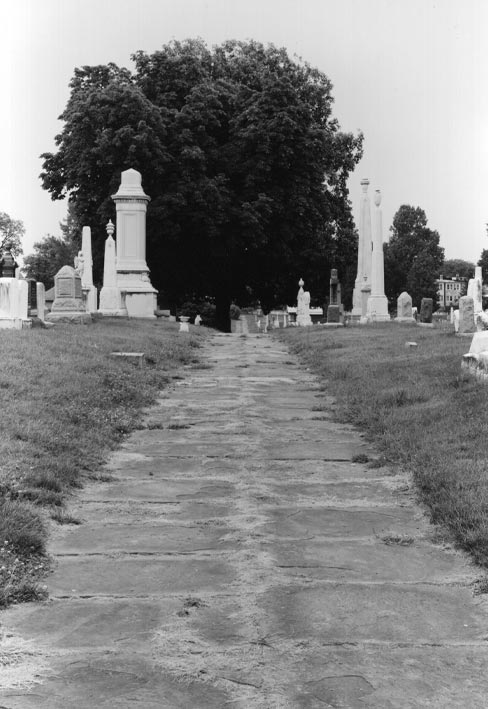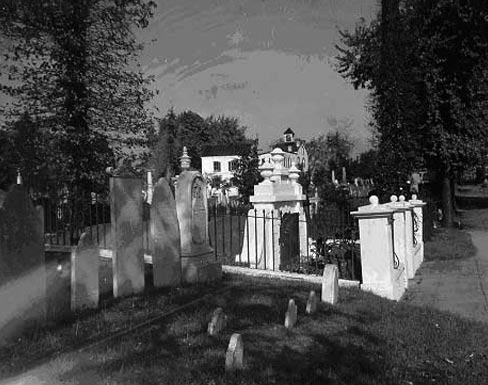Research Report
The Historic American Landscapes Survey Documents Congressional Cemetery in Washington, DC
by Julia A. Sienkewicz
Years before the establishment of Arlington National Cemetery, The New England Farmer and Horticultural Register took up the issue of Congressional Cemetery, Arlington's lesser known predecessor on the Anacostia River. "In the congregation of the dead," the Register noted, "you may study and catch the manners of the living, discovering in turn refinement or rudeness of taste, knowledge or ignorance, ostentation or modest retirement."(1)
The first national cemetery in the United States, Congressional offers insight into the evolution of cemetery design nationwide. In form, the cemetery, which began as a modest churchyard, reflects vernacular traditions but also bears the distinctive imprint of talented local craftsmen who were versed in the latest trends in architecture and landscape. Modified in the mid-19th century in accordance with the ideals of the rural cemetery movement, the cemetery was reworked a second time in the late 19th century to approximate a lawn cemetery. These developmental patterns, which are still evident in Congressional Cemetery's landscape, guided a recent pilot history project for the National Park Service's Historic American Landscapes Survey (HALS).(2)
The first project objective was to establish Congressional's place in the history of national cemetery design. The second was to test the effectiveness of the new HALS history guidelines for documentation of historic landscapes and, by doing so, help codify the new program's landscape documentation methodology.
The First "National" Cemetery
In 1807, the District of Columbia passed a law calling for the improvement of its two public cemeteries that had been in use without government supervision or regulation since 1798.(3) Henry Ingle, one of the three city commissioners named to carry out the act, also joined a group of private subscribers in founding a third cemetery. This new, privately-owned cemetery—known as Washington Parish Burial Ground and later Congressional Cemetery—was always envisioned as a "public" burying ground for the capital city even though it was to be given to Christ Church Episcopal once its subscribers had been repaid. Christ Church owned and administered the cemetery from 1812 until 1976, when it leased the operation of the non-denominational cemetery to the nonprofit Association for the Preservation of Historic Congressional Cemetery.
The transition from a public burial ground to a national one occurred in 1817 when the church donated 100 burial plots to the Federal Government for deceased congressmen and public officials who could not be transported to distant home states for burial. While extant records do not indicate the church's motives, it seems likely that the church elders desired to raise the cemetery's status. In the aftermath of the War of 1812, when the future of Washington, DC, was in question, they might also have seen an opportunity to solidify the government's ties to the city by creating a site for national commemoration. Almost immediately after this decision was made, the site came to be known as the National Burying-Ground, or Congressional Cemetery, and it rapidly developed into an important place in the national consciousness.
Key elements of the site date from the early- to mid-19th century when the cemetery occupied the limelight of national memorialization. During that time, the Federal Government installed identical sandstone cenotaphs over the site of each Congressman's grave, using a design traditionally credited to architect Benjamin Henry Latrobe (1764-1820).(4)(Figure 1) In 1832, a public vault was constructed to house the remains of government officials until arrangements were made for proper burial. Around 1857, the main entry path was paved with flagstones and lined with trees, accentuating the cemetery's role as a site of memory and ritual.(Figure 2) Perhaps most importantly, the Federal Government constructed a graded and graveled road in the 1850s to connect the then rural cemetery with the Capitol building. Although Arlington and other military cemeteries overshadowed Congressional's importance in the years following the Civil War, surviving features such as the cenotaphs, public vault, and flagstone path testify to the cemetery's national prominence during much of the 19th century.
Historic Cemetery Development Patterns
Congressional Cemetery also reflects the major trends in American cemetery design. The oldest square of the cemetery is in the form of a churchyard burial ground. The 1791 L'Enfant Plan for Washington provided the cemetery's underlying geometry. Additions to the burying ground included overlays of picturesque plantings and memorials mimicking the principal formal qualities of the rural cemetery. A final addition of ground was laid out in the manner of a lawn cemetery, a late-19th century trend characterized by the reduction in size and number of above-ground monuments and the elimination of many of the structured picturesque elements of the rural cemetery landscape. This layout allowed for more expansive and easily maintained stretches of turf.
Congressional Cemetery is exceptional because it combines a reform-minded cemetery design with a national iconographic program predating the rural cemetery movement. It also includes a cast of characters who are known for their work on other Washington landmarks from the same period. Besides Latrobe, the cemetery's first trustees, George Blagden, Griffith Coombe, and Henry Ingle, were all involved in the construction of the city's public structures, including the Capitol.
Following the HALS history guidelines, the Congressional Cemetery report combined a detailed contextual narrative with descriptive categories tailored to landscape forms, building on the time-tested historical report methodology used by the Historic American Buildings Survey (HABS) and the Historic American Engineering Record (HAER). The current features and conditions of this complex landscape also were recorded in large-format black-and-white photographs, including contemporary recreations—rephotographs—of selected views published in a 1913 cemetery brochure.(Figures 3 and 4) In many instances, the juxtaposition of historic and contemporary views reveals the changes in the landscape more effectively than any written description.
 |
Figure 4. This 2005 HALS view shows the public vault and flagstone path. (Photograph by James W. Rosenthal, courtesy of the National Park Service.) |
This HALS study has opened the doors for a future cooperative effort between the National Park Service's Cultural Resources GIS Facility and the Association for the Preservation of Historic Congressional Cemetery. The potential CRGIS project would create an interactive map and accompanying database to aid management and interpretation of the cemetery.
About the Author
A doctoral candidate in Art History at the University of Illinois, Urbana-Champaign, Julia A. Sienkewicz worked on the Congressional Cemetery HALS project while a Heritage Documentation Programs (HABS/HAER/HALS) summer employee in 2005. She may be reached via email at jsienkew@uiuc.edu. Inquiries regarding HALS documentation and guidelines can be directed to Paul A. Dolinsky, manager, HALS, paul_dolinsky@nps.gov.
Notes
1. "National Burying Ground: Extract of a Letter from one of the Editors, now in Washington," The New England Farmer and Horticultural Register 1, no. 26 (January 25, 1823): 206.
2. Julia A. Sienkewicz, HALS No. DC-1: Congressional Cemetery (Washington, DC: National Park Service, 2005). Other cemeteries recently recorded under the HALS banner include the Woodlands Cemetery in Philadelphia (HALS No. PA-5; completed in 2004) and several national cemeteries managed by the National Cemetery Administration (underway). For more information on the latter, see Sara Amy Leach, "The National Cemetery Administration's Documentation Initiative," CRM: The Journal of Heritage Stewardship 3, no. 1 (winter 2006): 74-78. HALS was created in 2000 in response to a growing interest in landscape documentation, following in the tradition of the Historic American Buildings Survey (HABS), founded in 1933, and the Historic American Engineering Record (HAER), founded in 1969.
3. "An act for the improvement of the Grave Yards in the City of Washington, for the appointment of Sextons thereto, and for other purposes," National Intelligencer and Washington Advertiser 7, no. 990 (March 20, 1807): 1.
4. The term "cenotaph" is used here because, while some of the monuments do, in fact, mark graves, others are purely commemorative. Latrobe is best known for his design for the United States Capitol during the early 19th century and other prominent commissions, including the Roman Catholic Basilica of the Assumption in Baltimore.



